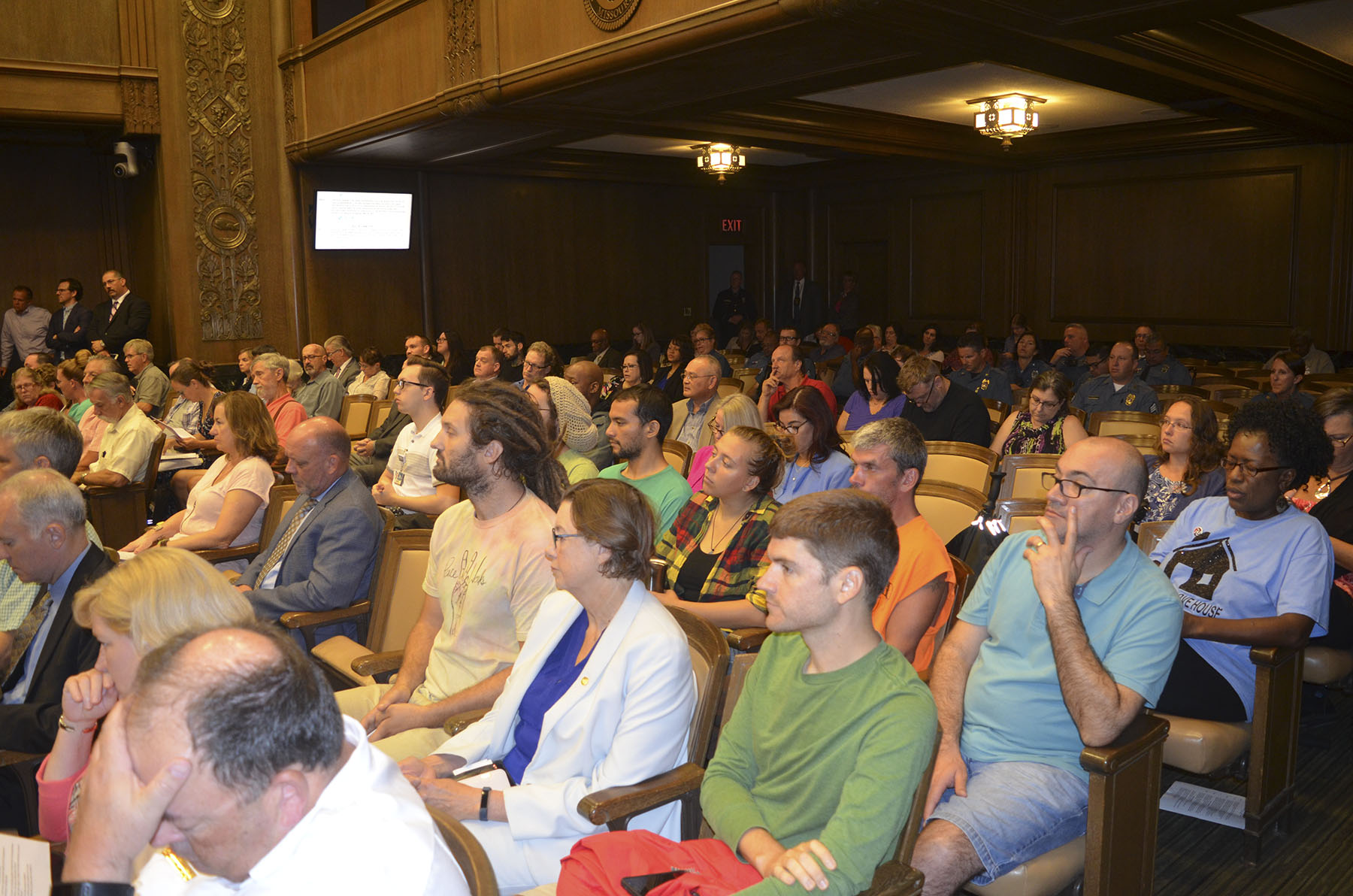
By Paul Thompson
Northeast News
A pedestrian safety ordinance designed to curb panhandling in Kansas City, Missouri needs to be refined before adoption, the City Council’s Transportation and Infrastructure committee decided after roughly three hours of debate and testimony on Thursday, August 30.
As written, the ordinance would have instructed pedestrians to proceed without delay as they cross streets in Kansas City. The legislation text targets panhandling by suggested that “No pedestrian shall stop, stand or remain in any intersection or crosswalk for a period longer than is necessary to safely traverse such intersection or crosswalk.”
The ordinance also contains language outlining similar restrictions related to medians, traffic islands, highway dividers, bridges, overpasses and viaducts. The Kansas City, Missouri Police Department presented the City Council committee with it’s rationale for supporting the ordinance, suggesting that service requests have soared in 2018, with panhandlers putting themselves in increasing danger as they have grown more aggressive.
Captain Doug Niemeier and Officer Jason Cooley, Community Initiative Officer for the Chief of Police, presented before the Transportation and Infrastructure committee on August 30. Niemeier pointed to the police department’s request for service regarding panhandlers as evidence that there is a problem, showing that while 191 such service requests were made in 2017, 202 have already been made through July of 2018.
“We have surpassed last year’s total, and this is just through July,” Niemeier said.
In addition to reported complaints involving panhandlers, Niemeier said that the City spends thousands of dollars every year to clean up transient camps and popular panhandling locations, which include the intersection of Bruce R. Watkins and Admiral, I-70 and Sterling, and I-435 and Wornall.
The ordinance was supported by seven Council sponsors, including 2nd District Councilwoman Teresa Loar, 1st District Councilwoman Heather Hall, 1st District Councilman Scott Wagner, 6th District Councilman Kevin McManus, 6th District Councilman Scott Taylor, 2nd District Councilman Dan Fowler, and 5th District Councilwoman Alissia Canady.
Hall lamented the rise of aggressive panhandlers in the City, recounting her experience of seeing pedestrians walk into lanes of traffic in the Northland.
“It’s everywhere, and what I’m concerned about is the pedestrian safety issue,” said Hall.
Still, not every member of the Transportation and Infrastructure committee was convinced of the legislation’s merits. Fourth District Councilwoman Jolie Justus was notably unconvinced that the ordinance in its present form is ready to be implemented, and asked a flurry of questions about the legislation.
“If someone is found in violation of this ordinance, what is the penalty?” Justus asked.
The answer to that question is somewhat uncertain, as a City attorney replied that the exact penalty would be decided by a municipal court judge. Because the ordinance itself includes no specific language related to penalties, a violation of the pedestrian safety ordinance would fall under the general penalty provision. Under that provision, fines of up to $500 could be handed down, along with a sentence of up to six months in prison.
In addition to issue of penalties, Justus also expressed concerns about what the ordinance doesn’t address: the glut of transient camps that have sprouted up throughout the city, measures to curb the increased aggression of panhandlers, and steps to address the behavior of motorists acting in violation of KCMO ordinances, in addition to pedestrians.
“I have a lot of concerns about the ordinance as it is drafted now,” Justus said.
Niemeier acknowledged that the pedestrian safety ordinance doesn’t solve every issue facing the city, but suggested that the legislation could be a tool for the police department to ensure that panhandlers aren’t putting themselves and motorists at risk. He further implied that the police department would phase in enforcement of the ordinance, much as it did earlier this year when the department began cracking down on illegal parkers downtown.
“I just feel like this is a step, and it’s a start. We want to make sure it’s right, too,” Niemeier said. “There needs to be an educational piece to this, much like we did with downtown parking.”
Kansas City residents on both sides of the issue flooded City Hall during the meeting to express their own opinions on the legislation. Committee chair Jermaine Reed first offered proponents the opportunity to speak on the issue.
Teresa Givens, owner of Learn a Lot Childcare at 4010 Sterling Ave. – in the shadow of one problem area described by Niemeier and Cooley – suggested that aggressive panhandlers have had a detrimental impact on her business.
“On any given day, a mother and child will arrive at our facility to find a grown man asleep at our front door,” Givens said. “They leave drug paraphernalia, they leave alcohol bottles, they defecate, urinate…police have actually witnessed them tearing off the windows and pulling off the doors.”
Givens added that female panhandlers around her business have even turned to prostitution, engaging in lewd acts within sight of her business.
“The women, now, have gotten even more aggressive,” Givens said.
John Bordeau of the Historic Northeast said that he’s seen an uptick of aggressive panhandling on and around The Paseo, with female family members and friends being accosted while stopped at intersections.
“I’ve seen rear-end accidents because of people stopping to give money. I think it’s a safety issue, and it’s obviously a quality of life issue,” Bordeau said. “It is one tool that we can use to start addressing the larger problems.”
Tony Fellers told of his own experiences in the Blue Valley neighborhood, where panhandlers collect money during the day and raid local businesses at night.
“They’re using your city streets during the day to panhandle,” Fellers said. “This is not the old army vet. This is someone who does not and chooses not to work.”
Those opposed to the legislation cited potential pedestrian concerns and pleaded for empathy over enforcement. Pedestrian and bicycling advocate Eric Bunch was one attendee who had questions about the ordinance as written.
“The concern we have is that it could have unintended consequences for those with mobility challenges,” Bunch said.
Winifred Wright of the Historic Northeast suggested that some motorists might feel uncomfortable facing Kansas Citians on medians who are struggling to make ends meet.
“While I appreciate that we have people here today who are trying to address the issues, I don’t really feel that this ordinance meets the mark,” Wright said.
Ultimately, the committee decided to allow more time to refine the ordinance before passing it on to the full Council. It is expected to be addressed again before the public on September 27.


















